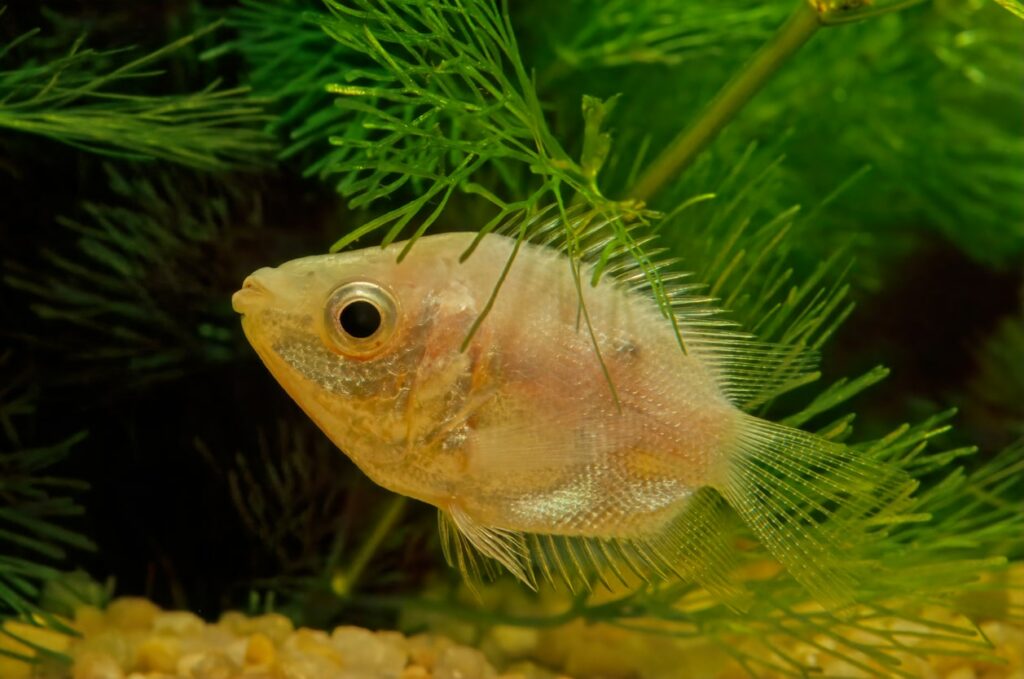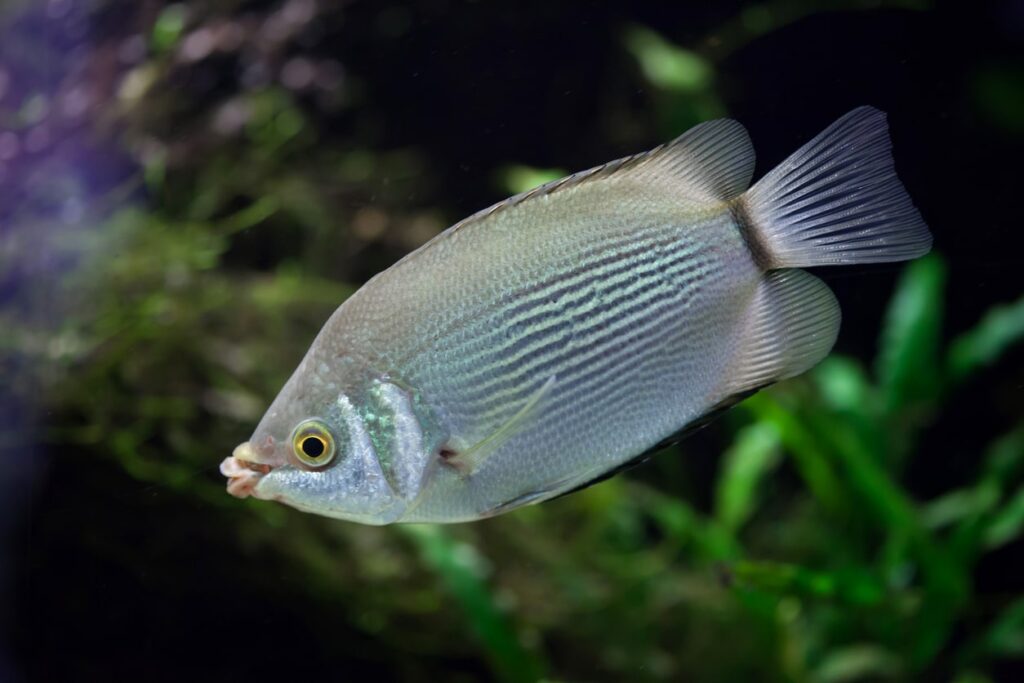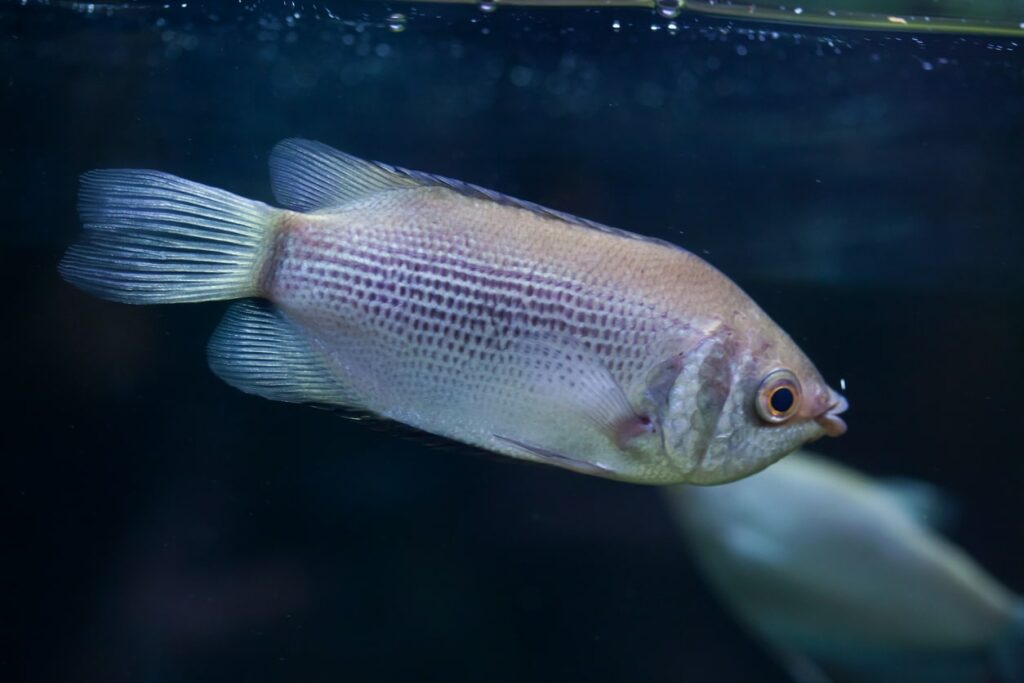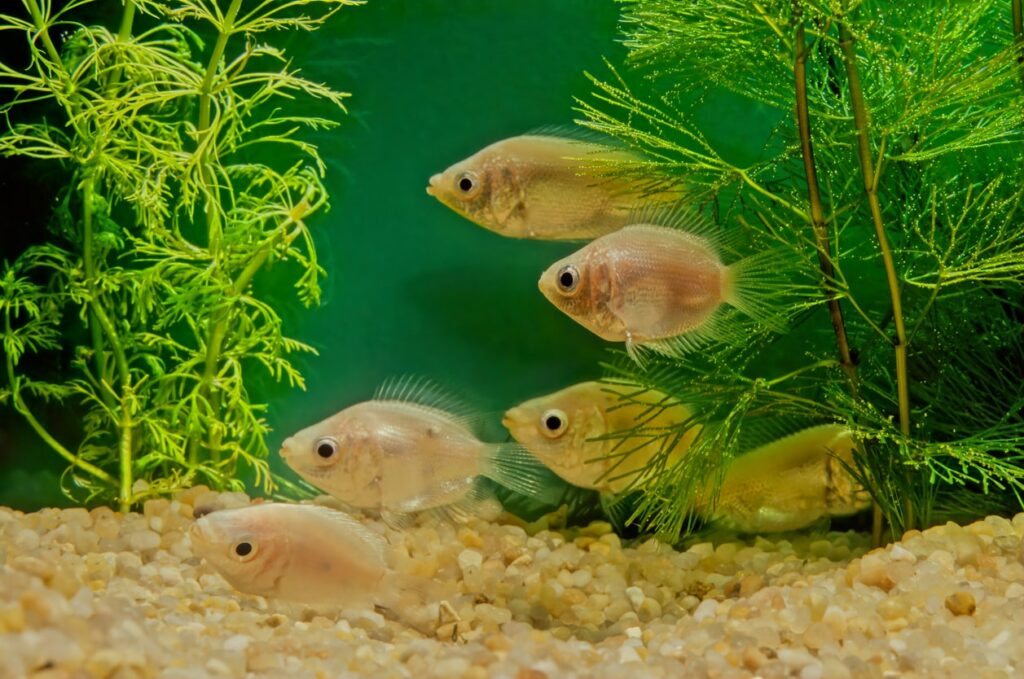Pink Kissing Gourami (Helostoma temminckii) are Southeast Asian (Thailand, Vietnam, Cambodia, etc) fish in the labyrinth fish group. This family also includes Bettas and other Gouramis.

Getting to Know the Kissing Gourami
These fish all share the ability to breathe air straight from the atmosphere using their complex labyrinth organ – if you’re a betta owner and have noticed how they gulp air every few minutes, this is why. Breathing air allows gouramis to survive in water too hot and low in oxygen for other fish. They can also feed on the aquatic insects and/or plants they love without competition!
Since Kissing Gourami get quite large, don’t need specialized food, and can survive in hot, low oxygen environments they are raised mostly as food fish throughout Asia. However they are popular here as aquarium fish for their delicate colors and strange habits. Believe it or not they DO kiss – but not for the reasons you think!
When sold in stores 99% of the time you’ll find the pink color morph; a leucistic variety that’s never developed pigments but isn’t a true albino. Normal Kissing Gouramis are a silvery green which are much less interesting to most aquarists.
Kissing Gouramis are very long lived, reaching up to 25 years in age in extreme cases. 10 to 15 years of life is more average for these robust gouramis. So when buying one know that you are entering a very long term relationship!
Let’s take a closer look at the Pink Kisser and see if they are right for you!
- Common Names: Kissing Gourami, Kissing Fish, Kisser Fish, Pink Kisser
- Scientific Name: Helostoma temminckii
- Origin: Southeast Asia
- Length: 12 inches
- Aquarium Size: 55+ gallons
- Temperament: Semi-aggressive
- Ease of Care: Easy
Caring for Kissing Fish
Aquariums for Kissing Gourami
Unfortunately, the majority of Kissing Fish sold in the hobby go to homes unprepared for their eventual adult size and longevity. They may look like small, cute, swimming hearts when little. But Kissing Gourami will easily reach 10 to 12 inches when fully grown. Remember, these are food fish in Southeast Asia and are robust enough to require plenty of swimming space.

A 55 gallon tank is an absolute minimum, with 75 gallons being better since it provides more turning room for the fish (18 inches wide vs 12 inches for a 55 gallon tank). The larger water volume also means you have more of a cushion to prevent poor water quality from impacting their health.
Also, please don’t buy fish that grow large thinking you will simply rehome them once they grow up! Pet stores and even public aquariums get phone calls from desperate pet owners all the time looking to rehome their fish. Pet stores usually will take rarer fish that are likely to resell but large adult Kissing Gouramis are not one of those.
Kissing Gourami and Aquascaping
In nature Kissing Gourami spend most of their time kissing hard surfaces like rocks for the slime that grows on them! This slime is composed of green algae, bacteria, and other microbes, forming a nutritious coating that few fish can take advantage of.
Normally some of this growth will arise once your aquarium is fully mature but the tank glass, plastic coating of filter tubes, and other surfaces aren’t the best at growing a nice, thick biofilm. Therefore, I recommend adding hard natural surfaces to your tank to grow algae and biofilm on because they are riddled with micropores for microbes to call home.
Driftwood is one of the best ways to feed biofilm feeders like Kissing Gourami and Bristlenose Plecos. Natural rocks like Seiryu Stone also provide plenty of surface area for your gouramis to graze on!
I also recommend keeping Kissing Gouramis with live plants. Live plants provide shade, use nitrogenous waste for fertilizer, suck up carbon dioxide, release oxygen, and help stabilize a mature aquarium ecosystem!
Just be careful which ones you choose because Kissing Gouramis are plant eaters. Softer plants will be munched on daily. But tough leaved types like Amazon Swords, Java Fern, and Anubias will be able to stand up to most vegetarian fish. Even plants with average toughness like Amazon Sword plants should be fine so long as your Kissing Fish are well fed!
Water Parameters for Kissing Fish

Kissing Fish are remarkably adaptive when it comes to water conditions; it is why they are so popular as food fish back in their native land. They are very resistant to ammonia, nitrite, and nitrates, making them good first fish for cycling an aquarium if you don’t want to fishless cycle.
That said, a fish being resistant does not mean we should be lazy and stress our pets unnecessarily. We should always keep up with regular water and filter maintenance! You will need a larger filter as your Kissing Gourami grows up since large fish that eat mostly plants also create loads of waste. A canister filter or larger power filter will do a good job of getting all that poop broken down!
Kissing Gourami are also flexible when it comes to water chemistry. A pH of 6.0-7.0 is what they prefer but even moderately alkaline conditions (pH 7.0+) are fine since they have been aquarium-bred for decades. They do prefer warm water, however – temperatures of 75-84℉. Colder water can lower their resistance to disease and diminish their appetites so don’t go much cooler than 75℉. whenever possible.
Kissing Gourami Tank Mates
Another aspect to Kissing Gourami care that many aquarists don’t realize is that they are semi-aggressive fish that tend to bully their tank mates. This behavior is usually strongest when they are confronted with fish that are similar in shape, size, and color. The less like a Kissing Gourami they look, the less likely your gourami is to try bossing them around.
Aggressive behavior is usually limited to the Kissing Gourami trying to “kiss” the sides of other fish and push them around. They don’t have large teeth but they do have rasping lips that can strip away not only algae but also mucus, skin, and scales from their tank mates.
Other large, semi-aggressive fish are best to keep alongside them. Medium to large Cichlids are a good choice since they won’t put up with being bullied in this way. Peaceful fish that are entirely dissimilar to Kissing Gouramis in appearance are also a good match.
This includes Clown Loaches, Plecostomus, larger Barbs, Rainbowfish, and many other species! It is best to stay away from other kinds of Gouramis since they will be immediately targeted for harassment.
Why Do Kissing Gouramis Kiss?
You’ll only ever see this kissing behavior when keeping Kissing Gouramis together. And even then only the males will kiss each other. This “kiss” is actually a form of ritualized aggression; they use their broad lips to make contact and test each other’s strength.
So it’s more like armwrestling than kissing. Except Kissing Gouramis don’t have arms and have to make do with the only appendage they have: their fleshy lips!
If you keep Kissing Gouramis alone they won’t try to kiss other fish – usually. Sometimes if they aren’t well fed, Kissing Gouramis may place their lips against the flanks of other broad bodied fish, like Angelfish or Discus. However, this isn’t a kiss – it’s a straight up bite! The Kisser is either aggressively attacking what it thinks is a rival or trying to steal mucus from their flanks, which is rich in protein and vitamins.
Eating mucus from other fish is not only bad manners, it opens their skin up to opportunistic diseases like ich and skin fungus. So keep your Gourami well fed – and move your fish around if it seems like they’ve developed a habit for picking at their tank mates.
Feeding Kissing Gourami

Kissing Gourami are very easy to feed because they are by nature generalist grazers. In the wild they live in ponds full of thick plant growth, suspended phytoplankton, algae, and insect larvae. These fish have filters built into their gills that allow them to strain phytoplankton (green water algae) from the water. They use their thick lips to scrape algae from hard surfaces like rocks, driftwood, and aquarium glass. And they also eat soft plants like Cabomba and Elodea.
However they do require some animal protein in the form of insect larvae, small snails, worms, and other tiny invertebrates. In the aquarium they will greedily eat prepared pellets and flake food formulas.
Just take the time to read the ingredients label and be certain your favorite blend isn’t poor quality. If you see filler additives like potato, wheat, corn, or soy in the first few ingredients, stay away! Stick to whole fish meal, spirulina, algae meal, and other nutrient rich ingredients!
Frozen and live foods like brine shrimp, bloodworms, and tubifex are welcome additions to their diet as well! Just go easy on fresh animal protein – remember, these fish are primarily vegetarian.
Since Kissing Gourami love their vegetables you can also provide terrestrial greens like lettuce, spinach, or zucchini for them. Lightly boil any fresh vegetables for 5 to 10 minutes before you clip them in the tank. This softens them enough to be easily picked apart and digested by your fish. Just be sure to remove them once it looks like your fish are full – boiled vegetables can cause cloudy water to arise very easily!
Breeding Kissing Gourami
Breeding Kissing Gourami is entirely possible to do in a home aquarium but it’s not as easy as with other fish. The main challenge to breeding Kissing Fish is that one, they are fairly large, and two, telling the sexes apart is next to impossible.
Male and female Kissing Gourami don’t have external sexual differences for us to visually tell them apart (they are not sexually dimorphic). The fish can likely tell each other apart from subtle behavioral or hormonal/smell cues. If you see two fish regularly kissing, then you know you’re looking at two males testing each other’s strength. The ones not kissing are more likely to be female, especially if you see your confirmed males chasing them around for attention.
Unlike most gouramis and bettas, Kissing Gourami don’t build elaborate bubble nests to lay their eggs in. They may blow a few bubbles but it’s more of a preparatory behavior – a sign of readiness to spawn. Males will seek out clumps of floating vegetation and then try to lead ready females underneath his chosen “nest.” So stocking the breeding aquarium with thick floating plants like Hornwort will make it much more likely that your fish spawn.
Once he finds a ready female the two embrace under his floating plant raft. The eggs float upwards and then he departs, leaving them to fend for themselves. The eggs hatch fairly quickly and the fry take 48 hours to use up their yolk sack.
After this point they become free swimming, feeding on infusoria and other microbial life, until they grow large enough to feed on small items like baby brine shrimp, green water algae, and biofilm!
Kissing Gourami FAQ
Kissing Gourami don’t kiss in the usual sense; meaning a show of affection or sexual attraction. Kissing Gourami males kiss as a display of dominance. Many fish actually do this, especially cichlids. It’s called “lip locking” and it’s a form of wrestling. But the big, fleshy lips of Kissing Gouramis make it look more like a kiss than the bite that it really is!
Not at all. Kissing Gourami do socialize a bit. But they tend to be aggressive towards each other, especially males. And since you can’t tell the sexes apart visually, it’s much better to either keep them with other fish alone or in a small group of Kissing Gouramis, which spreads out the aggression.
They are semi-aggressive fish, meaning they will occasionally harass their tank mates but rarely to death. The more another fish looks like a Kissing Gourami in size, color, or behavior, the more likely the Kisser is to pick at it. Keeping them with highly dissimilar fish is the best way to keep everyone happy. Or fish that are equally aggressive.
Kissing Fish are fairly large as adults and will reach 10 to 12 inches in size. So a 55 gallon aquarium is an absolute minimum, with 75 gallons being much better for them.

